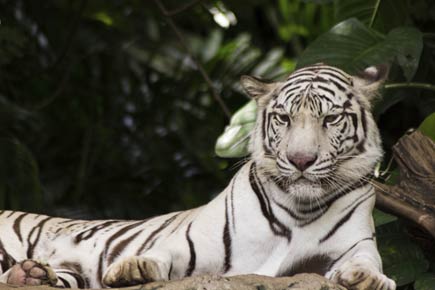The roar of white tigers will once again reverberate in Madhya Pradesh's Vindhya region, where the feline was first found in 1951, with the world's first 'White Tiger Safari' to open for public at Mukundpur in Rewa division on April 3

white tiger
Bhopal: The roar of white tigers will once again reverberate in Madhya Pradesh's Vindhya region, where the feline was first found in 1951, with the world's first 'White Tiger Safari' to open for public at Mukundpur in Rewa division on April 3.

Representational picture
ADVERTISEMENT
Union Minister of State for Environment and Forest Prakash Javadekar, Steel and Mines Minister Narendra Singh Tomar and Madhya Pradesh Chief Minister Shivraj Singh Chouhan, among others, will dedicate to the public the world's first Mukundupur White Tiger Safari Zoo and Rescue Centre on Sunday, state Public Relations and Energy Minister Rajendra Shukla told PTI today.
The zoo will have three white tigers, including a male named Raghu and two females - Vindhya and Radha. "The mention of white tigers has always thrilled me since childhood. I was fortunate enough to see a roaring white tiger, named Mohan which was caught by the then King, Maharaj Martand Singh in Govindgarh Palace. Singh caught it on May 27, 1951 while hunting tigers in Deva village forest area in Sidhi district," said Shukla, who belongs to Vindhya region.
"This white tiger cub (Mohan), which was captured from a cave near Kormar river by the hunting team led by Martand Singh later became the progenitor of all the white tigers in the world," he said.
Author Jairam Shukla, who has written a coffee table book 'Tale of the White Tiger', said, "It is a progeny of Royal Bengal Tiger that has got the amazing white hue because of a gene mutation. It is not a different species, but a genuine Indian tiger."
"Its zoological name is Panthera tigris-tigris. Both the white and the yellow tigers come from the same stock, but with a hereditary chromosomal change. The habit and the habitat are the same, the life cycle is the same. Normal age ranges from 16-20 years," he said.
The white tiger has always thrilled and mesmerised the world. Majority of researches on wildlife have been focused on this species. The mystery for them was how the yellow tiger turned white, making the gene mutation the focal point of their researches at large, Jairam said.
"When Martand Singh first captured a white tiger cub in his hunting drive, probably he had not thought that he was going to create history. Since its capture, the fame of this white tiger (Mohan) was spread all over the world. Wildlife scientists from across the world made a dash to Govindgarh in Rewa to unravel this mystery of nature," he said.
"On their advice only, the propagation of white tiger was initiated," he said. Between the decades of 50s and 70s, the white tigers even became an instrument of India's cultural relations with foreign nations, said Jairam.
"We can say that white tigers in a manner played the role of India's cultural ambassadors," he said. He said that in 1960, the US expressed its interest in the white tiger following which a delegation visited Rewa and took one to their country.
"How intense was the fascination for this amazing creature can be gauged by the fact that when white tigress Mohini reached Washington from Govindgarh the then US President W D Eisenhower received her," he said.
Jairam also informed that another white tiger couple from Govindgarh was sent to Bristol Zoo in England in 1963. Minister Rajendra Shukla recalled that when Mohan died on December 18, 1969, a holiday was declared in local schools and markets were closed as a mark of respect for the departed white tiger.
Later, Virat and Chameli was the last couple of white tigers that lived in Govindgarh till July 8, 1976. But after Mohan's progeny Virat died, his companion Chameli was shifted to Delhi Zoo and that is how the Vindhya region, which is credited with introducing white tigers to the world, got deprived of the felines since then.
Later, relocating them back in the Vindhya region became a major political issue in many elections and when Shukla was the forest minister, he initiated the issue again which resulted in the creation of Mukundpur White Tiger Safari Zoo and Rescue Centre, he added.
 Subscribe today by clicking the link and stay updated with the latest news!" Click here!
Subscribe today by clicking the link and stay updated with the latest news!" Click here!







